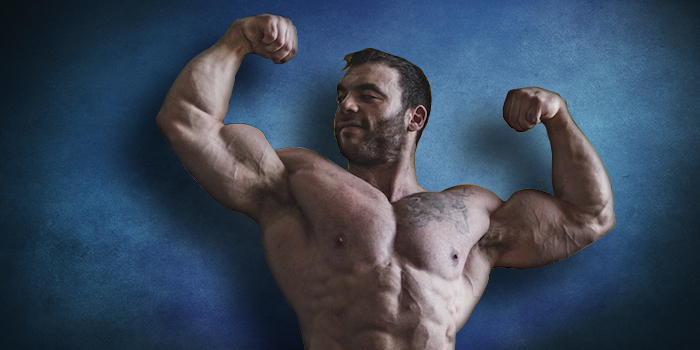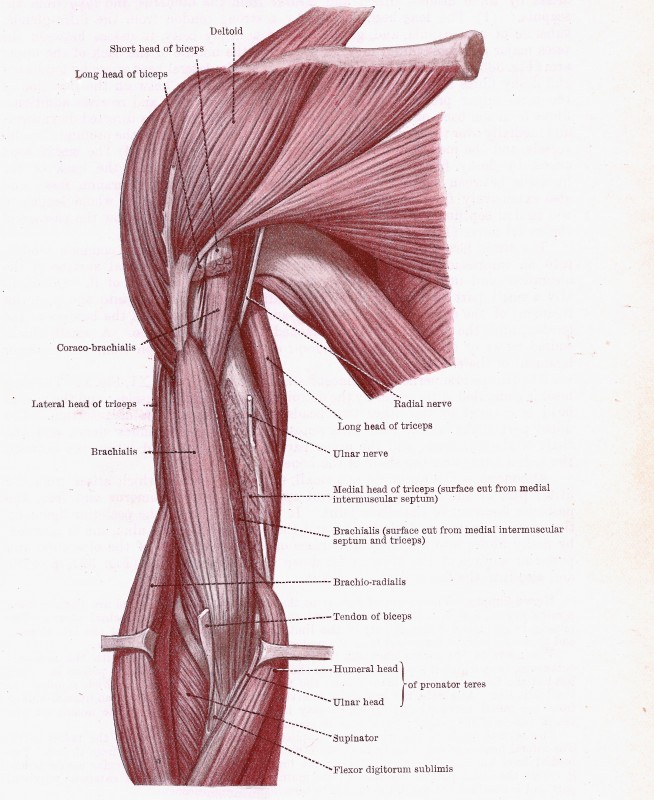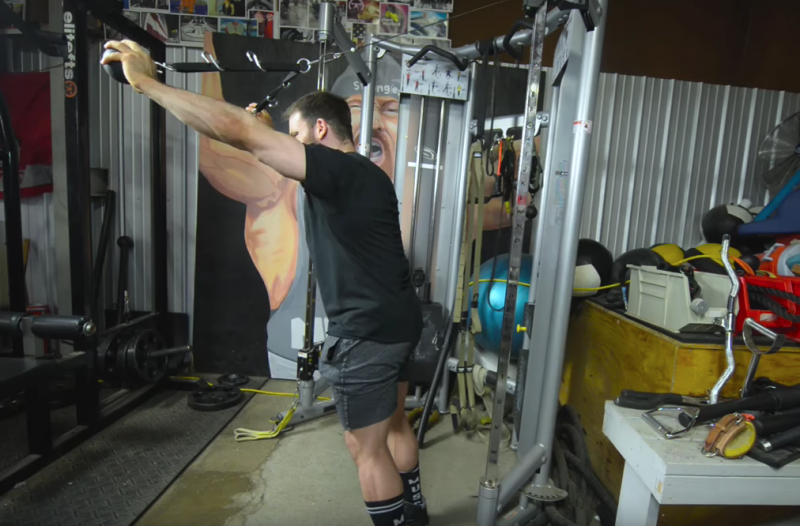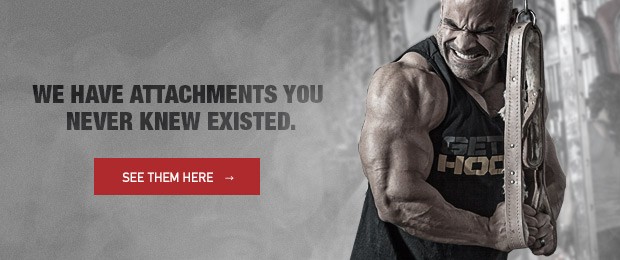
The Bodybuilding for Powerlifting series describes how you can incorporate bodybuilding methods into your powerlifting training for big benefits in strength and aesthetics. This installment continues where the first article on arm training left off. For a refresher, you can review part one here.
In the first part of this series, I discussed how arm training—which often ends up on the powerlifting backburner—is actually very valuable. No, hammer curls and pushdowns probably aren’t going to add 50 pounds to your bench, but they very well might keep your elbows healthy enough so that you can train consistently. Over the long term, that’s an extremely important component of success. Let’s be real, though. Injury prevention might be necessary, but it’s not fun. Getting arms big enough to bust through your shirtsleeves is fun, and even if you’re primarily focused on building strength, you can incorporate direct arm work without detracting from the other major movements in your training. To do that, though, you’ll need to carefully plan and choose which exercises you need to use and how best to use them in the context of your overall program. The rest of this article explains how to do that.
Image credit: Steve Estvanik © 123rf.com
Basic Anatomy
First, let’s start with some basic anatomy. The emphasis here is on basic; this section really oversimplifies the complexity of the body, but the truth is that you don’t need a medical degree to get 21-inch guns. You do need to understand the different parts of your arm and how they contribute to size and strength. You probably already know that the triceps muscle is actually made up of three heads: the lateral, or outside, head forms the “horseshoe” shaped part, and the long head makes up most of your triceps mass. The third head, the medial one, mostly runs under the long head.
Here’s what you actually need to know about triceps anatomy: if your arms are just too small, you probably need to focus on the long head, which is easiest using exercises that involve extending the arms in the overhead position. If your arms are pretty decently-sized but lack a lot of “pop,” especially when viewed from the front, you might want to do a little more work for the lateral head. Both are important when it comes to locking out a heavy bench press, so if you’ve neglected one or the other, you could very well improve your bench by training both equally. There are situations where you’ll have a lagging medial head, but in my experience, it’s pretty rare, because exercises that hit the lateral head usually hit the medial one, too.
The two muscles you want to think about for biceps training are the biceps (duh) and the brachialis. Kind of like the medial head of your triceps, the brachialis runs under the bicep, so it’s usually not visible (unless you’re really lean; I’ve only recently noticed mine popping out, which is cool) but will contribute to the overall size of your arm. It’s easiest to train your brachialis using neutral-grip curling movements, like hammer curls. The trick is keeping your wrist neutral throughout the range of motion, as it’s very easy to cheat by breaking at the wrist just slightly. You might not even notice you’re doing so unless you’re really focused.
The biceps itself has two heads (inner and outer), but typically, they’re pretty evenly developed. If you feel that one of your biceps heads is lagging, you can target the outer head a little more by bringing your elbows slightly forward as you curl (the outer head has some involvement in shoulder flexion). Unlike the triceps, biceps won’t directly contribute to your powerlifting strength. Still, I can’t quite agree with Ed Coan’s sentiment about biceps being akin to Christmas tree ornaments; balanced development of all muscle groups is crucial for injury prevention.
Programming
Programming direct arm training isn’t difficult as long as you remember two things:
- It’s best not to train biceps or triceps isolation movements with very heavy weights, as it’s just too easy to beat up your wrists and elbows.
- Tired biceps and triceps can affect your squat, deadlift, and especially bench press, so it’s important to consider the volume and timing of your arm training with respect to your weekly schedule.
My general recommendations are pretty simple. First, I find that the arms benefit from a high training frequency and lower training volume. In other words, you’re usually better off hitting them, say, twice a week with a moderate number (six to eight) of sets rather than having one dedicated all-out arm day where you try to blast your biceps and triceps into smithereens. The higher frequency, lower volume approach can work with any muscle group, but it’s especially effective for arms because you’re probably also hitting them with many of your pressing and pulling movements, so it can be pretty easy to overreach.
I also (strongly) recommend that you stick to pretty high-rep training when it comes to arms: sets of 10 to 20 or even more reps. Again, the wrist and elbow joints are pretty small ones, and if you’re directly loading them with enough weight to be challenging for a set of four to six reps, it’s pretty easy to wind up with nagging aches and pains. Performing higher reps also makes it easier to get a great pump, which won’t do much for your strength but will have hypertrophy benefits. If you really hate high-rep training, maybe try performing multiple sets of slightly lower reps and taking very short rest periods between sets.
Movements
Appropriate movement selection is just as important as appropriate programming. Fortunately, because so many bros love training their guns, you won’t struggle to find a wide variety of exercises to choose from. It’s important that you don’t just pick a couple at random, though. You need to deliberately select movements that will target your weaknesses, and you need to realize that even small nuances in how you perform those movements can have a drastic impact on your ultimate results. I obviously don’t know your weaknesses, but I can share some of my favorite arm exercises to help give you a little inspiration.
Tate Press
This is one of my all-time favorite triceps exercises, named for one of my all-time favorite powerlifters. You can learn how to perform the Tate Press here, but the really important thing to remember is that you’re using these to focus on the outer head of the triceps. To do so, you need to make sure that you’re keeping your wrist in a neutral position through the entire range of motion and that you’re keeping your upper arm in a fixed position.
Rolling Dumbbell Extensions
These are essentially skullcrushers, but using dumbbells makes it easier to isolate the triceps; I find that a straight bar often encourages the use of the lats and shoulders, or degrades into some sort of ugly pullover. You can read more about rolling extensions here.
Banded Reverse-Grip Pushdown
Using a reverse grip helps to target the long head of the triceps, and using bands helps to keep constant tension on the muscle. With pulleys, you’ll often relax in the fully stretched position, which is not ideal. I usually use a light band for these.
Hammer Curl
Hammer curls are a mixed bag. They’ll smash your brachialis and the outer head of your biceps, giving your arm that thick, powerful look that everybody wants. On the other hand, hammer curls are so damned easy to cheat that it can be difficult to load them heavily. My best suggestion is to use the cross-body style and focus on keeping your wrist in a neutral position throughout the entire range of motion. Tossing in a brief squeeze in the fully contracted position or using a slow eccentric can help force you to control the weight, too. For a twist, try doing hammer curls with kettlebells.
Thick Bar Curl
Using the thick bar obviously helps to sneak in a little extra grip and forearm work, but in addition, the thick bar can be slightly easier to control if you perform your reps properly. When you begin a rep, you should be leaning forward slightly so that your arms are perpendicular to the ground. As you curl, bring your elbows forward just a bit and stand up straight. Then lower the bar by “dragging” it down the front of your body (this is where the thick bar helps because it won’t get caught up on your clothes or skin as much). This technique will make it easier to avoid using your shoulders and low back in the movement.
Sample Routine
Triceps A (Best After Heavy Benching)
- Tate Press: One warm-up set should be plenty. Then do one set of 10 reps with a weight you could use for 12. We’re not going all-out so that you can focus on keeping those elbows and wrists in a good position. Rest two minutes, and then perform a second set of max reps with the same weight.
- Reverse-Band Pushdown: Set the band tension so that you can do manage one set of 20 reps without quite going all-out. Then perform 100 reps in as little time as possible.
Triceps B (Rest Two to Three Days After Before Benching Heavy Again)
- Rolling Dumbbell Extension: I like to pyramid these. It’s too easy to cheat if you start with a heavy weight. Instead, start with a pretty light weight and perform one set of 15 to 20 reps. Then rest one minute, add weight, and perform a second set of 12 to 15 reps. Repeat for sets of 10 to 12, eight to 10, and six to eight (five total sets).
- Triangle Push-Up: An oldie-but-goodie, these are super easy to learn and super hard to get good at. Do two sets of max reps with bodyweight, resting two to three minutes between sets.
Biceps A (Perform Anytime)
- Hammer Curl: Like the rolling dumbbell extension, it’s just too hard to cheat if you go straight to a heavy weight. Still, we want to use fairly heavy weights on this exercise. So warm-up thoroughly, with two three lighter sets. Then do two heavy sets of six to eight repetitions with a weight you could use for 10, resting two minutes between sets.
- One-Arm Spider Curl: We’re snagging this exercise from part one. Do two sets of 12 to 15 reps. These are unilateral, so there’s no need to rest between sets. Just go from the right arm to the left, back to the right, and then end on the left.
- Finisher: After you finish the dumbbell spider curls, rest two minutes. Then grab a pretty heavy barbell, a little heavier than twice the weight of the dumbbell you used on the spiders. Perform one set of max spider curls with the barbell. When you finish, just hold the bar at the bottom for as long as possible. After all the other biceps work, this loaded stretch will be very difficult.
Biceps B (Okay Anytime)
- Incline Dumbbell Curl: We’re doing these exactly like the reverse-band pushdowns. Choose a weight that allows you to do one set of 20 reps with good form and without quite going all-out. Then perform 100 reps in as little time as possible.
- Thick Bar Curl: I like training these in a fatigued state because if you load them too heavily too quickly, it can be easy to develop a little tendonitis from so much grip work. You won’t be able to use much weight after the incline curls, so just do two sets of eight to 12 reps, resting two minutes between sets and using a very slow and controlled eccentric (three seconds is a good bet).
Wrapping Up
Above all else, remember that programming is a holistic process. You can’t really train anything in total isolation, so whether you’re talking about arm work, bodyweight exercises, sports training, or anything else, it’s important to remember that a small change in one area can create changes in another, too. It’s also important to remember that everyone responds to training differently, so there’s no one right answer. You’ll have to experiment a little to find what works for you. If you can learn to do that, you’ll end up far bigger and stronger than almost everyone else in the world.











